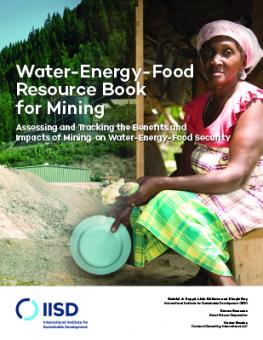
Water-Energy-Food Resource Book for Mining
This manual briefly explains IISD’s water-energy and food security framework.
Water, energy and food (WEF) security are interlinked and co-dependent components of security and ranked by the World Economic forum as a key global risk.
As attention to WEF security has grown, so has a need for practical means of implementing this complex, interlinked problem. The WEF security analysis tool (WEFsat-Mining) was developed as part of a multi-year initiative to operationalize a framework and implementation plan to assess WEF security, understand the impacts and implications of mining, and provide guidance to decision-makers on how to optimize across different priorities, including economic, social and environmental.
This manual briefly explains IISD’s WEF security framework. Informed by a comprehensive literature review, this framework enables a place-based analysis of four main components that focus the obvious and underlying factors affecting a community’s ability to be WEF secure: access, availability, supporting resources and supporting policies, and each in the context of a region’s water, energy and food supply. The WEFsat-Mining tool seeks to facilitate the operationalization of this framework in the context of mining with a focus on understanding and managing the benefits and impacts of mining on community-level WEF security. This guidance manual then walks the reader through a series of steps included in the WEFsat-Mining tool, including its 10 MS-Excel worksheets. These are: #1 Community profile; #2 WEF inventory base; #3 WEF Status base; #4 WEF diagram base; #5 Mine profile; #6 WEF inventory- mine; #7 WEF influence- mine; #8 WEF mine-composite; #9 WEF mine diagram; and #10 Executive Summary.
You might also be interested in
WEFsat-Mining Tool User-Guidance Manual: Water, energy and food security analysis tool for mining
Water-Energy-Food Security and Mining in Suriname: A project overview
Water, energy and food security constitutes critical components of human well-being and includes aspects of supply, demand and access to all three.
Water-Energy-Food Security: What are the potential contributions of the mining industry?
IISD Annual Report 2023–2024
While IISD's reputation as a convenor, a trusted thought leader, and a go-to source on key issues within the sustainable development field is stronger than ever, the work happening outside the spotlight is just as valuable.